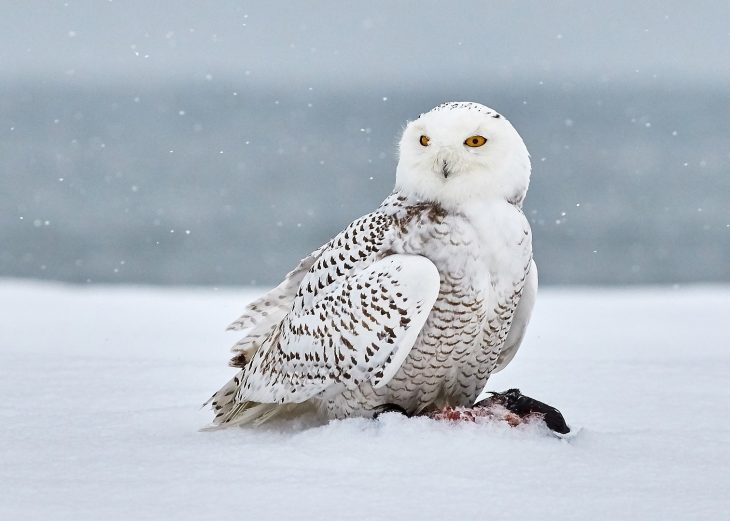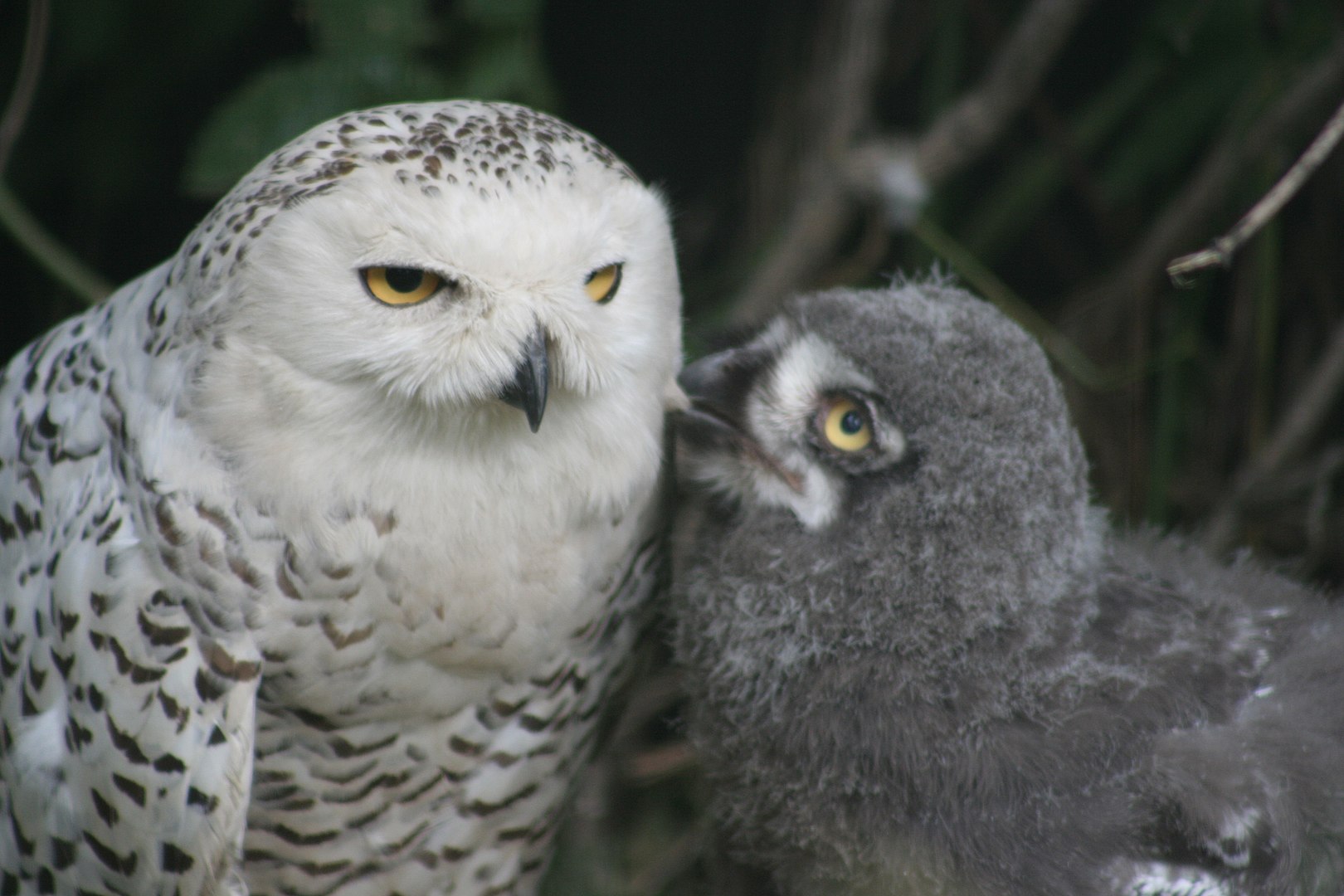
As white as the frozen lands they live on, snowy owls offer quite the sight in the regions they call home. Notorious for their territorial nature, not even humans are safe from the snowy owl’s wrath. However, behind their bad temper are unique birds with fascinating behavior that keeps scientists on their toes. Find out more about these Arctic animals with these snowy owl facts.
- Snowy owls grow to an average of 59 cm long.
- The biggest snowy owl on record stood 70 cm tall.
- A snowy owl’s wingspan can reach up to 166 cm.
- On average, they weigh around 1.66 kg.
- Scientists estimate that 100,000 snowy owls live in the world today.
- Genetic studies point to snowy owls first appearing around 4 million years ago.
- Great horned owls are the snowy owls’ closest relatives.
- Snowy owls once lived as far south as Italy and Bulgaria during the last Ice Age.
- Snowy owls also grew much bigger during this time compared to today.
- Carl Linnaeus included snowy owls among the bird species described in his 10th Edition of the Systema Naturae from 1758.
- It was also Carl Linnaeus who gave them their first scientific name: Strix scandiaca.
- Today, scientists have renamed the snowy owl Bubo scandiacus.
- Bubo comes from the Latin for horned owls, referencing their closest relatives.
- Scandiacus refers to their origin in Scandinavia.
- Many scientists today contest this change, though, and prefer Linnaeus’ original name for the bird.
- Snowy owls constantly migrate around and across the world’s arctic regions.
- Snowy owls usually feed on rodents and water birds, but will also scavenge if they have to.
- Unlike other owls, the snowy owl isn’t nocturnal, commonly flying and hunting in the daytime.
- International organizations today consider the snowy owl a vulnerable species.
- Other names for the bird include the Arctic owl, the polar owl, and the white owl.
Snowy owls have a distinctive appearance.
Throughout the animal kingdom, snowy owls are the only owls that have a primarily white plumage. Adult males of the species actually have a pure white coat of feathers, while females have small flecks of brown in their plumage.
Young snowy owls of both genders have the brown flecks, but only females keep them in adulthood. In fact, scientists use the flecks and the rate they disappear as a way to identify the age of specimens that they find. How’s that for colorful snowy owl facts?
Snowy owls also have a distinctive call compared to other owls.
Most owls make the hooting sound that people usually associate with their kind. While snowy owls do hoot, they have a unique barking quality to their voices that other owls don’t have. To date, scientists have recorded 15 different variations of snowy owl calls, which the birds use for varied purposes. Typically, snowy owls “bark” to warn other birds against entering the owl’s territory. Meanwhile, males may also bark to catch attention from females looking for a mate.
Snowy owl hatchlings also have a unique call of their own, which they lose when they reach adulthood. Upon hatching, snowy owls produce a high-pitched series of squeaks that develop into a high-pitched scream. This call helps the mother owl find the hatchlings in case they get lost.
Snowy owls also like to sit on the ground.
Here’s an interesting example of Snowy Owl Facts. Unlike other birds, snowy owls don’t like perching on or even making their nests on trees. Instead, they prefer to stay on the ground, building their nests in secluded, grassy places on the Earth’s surface. Scientists believe that the birds evolved this behavior as a result of their short and broad legs, which make it difficult for the snowy owl to perch on a tree for extended periods.
Snowy owls don't have to mate for life.
While rare, scientists have records of snowy owls having more than one mate. Usually, a male would mate with 2 females, but the opposite also happens in the wild. However, it’s much rarer for females to exhibit polygamy.
Snowy owls usually lay their eggs in May.
On average, snowy owls usually lay 8 eggs, staggered out over a period lasting around 10 days. At most, snowy owls may lay up to 11 eggs, and as few as only 5 eggs. It takes around a month for the eggs to hatch, with the parents feeding the hatchlings until October at most.
This also marks the beginning of the snowy owl’s migration season, in which the parents and their young go their different ways. However, young owls may also leave the nest as early as August.

Snowy owls are very protective of their nests.
As a territorial species, snowy owls would defend their nests even against humans, unlike many other kinds of birds that fear us. Upon detecting a threat to their nest, snowy owls would try to scare the threat away by fanning out their wings and feathers.
If that doesn’t work, the owls then dive-bomb the trespasser, slashing at them with their beaks and talons. While no records exist of humans dying from snowy owl attacks, many records do exist of serious head injuries. Usually, the reason for these owls attacks involved humans getting too close to the owls’ nest. Now, there’s one of the snowy owl facts you’d have to watch out for in the wild.
Snowy owls can live for a very long time.
In captivity, snowy owls can live up to 30 years, but they usually only survive an average of 25 years. In the wild, they tend to have shorter lifespans, averaging around 10 years. However, scientist have also encountered 23 year-old snowy owls in the wild.
Climate change poses a major threat to the snowy owl’s future.
Rising temperatures have led to increased rainfall and reduced snowfall in the snowy owl’s home regions. In turn, this has impacted the local rodent populations, which make up the snowy owl’s main food source. From 1998 to 2000 alone, changes in temperature and its effects on local rodents reduced the snowy owl’s food by as much as 98%.
Global warming also affects the snow owl directly, as they have limited ability to cope with high temperatures. In particular, scientists have noted a rising trend of snowy owls dying from heatstroke over recent years.
The snowy owl has appeared in popular culture.
The most famous of them all is probably Hedwig from the Harry Potter franchise. As shown by his plumage, Hedwig was a male snowy owl who served as Harry Potter’s pet and messenger bird.
The French Air Force named their drone system after the snowy owl.
Known by the French as harfang des neiges, these drones first launched in 2006. Named after the snowy owls, the Harfang System carried advanced radar and other sensor technology, which served the French military as unmanned scouts. Through these drones, the French could get information about the enemy without actually putting the lives of soldiers at risk.

Was this page helpful?
Our commitment to delivering trustworthy and engaging content is at the heart of what we do. Each fact on our site is contributed by real users like you, bringing a wealth of diverse insights and information. To ensure the highest standards of accuracy and reliability, our dedicated editors meticulously review each submission. This process guarantees that the facts we share are not only fascinating but also credible. Trust in our commitment to quality and authenticity as you explore and learn with us.
